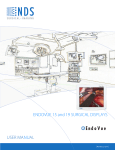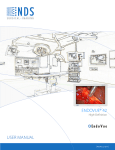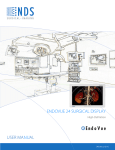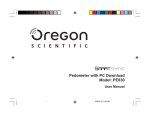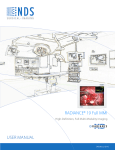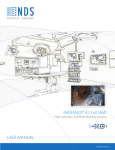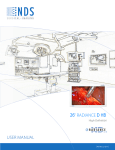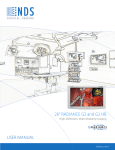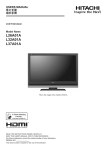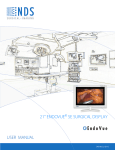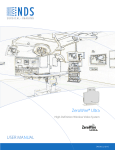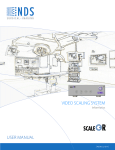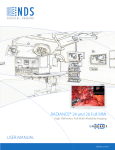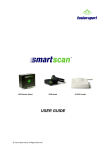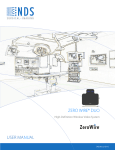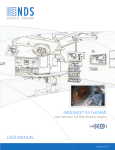Download USER MANUAL ENDOVUE 24 SURGICAL DISPLAY
Transcript
ENDOVUE 24 SURGICAL DISPLAY User manual [ English] © 2012 NDS Surgical Imaging, LLC. All rights reserved. Information in this document has been carefully checked for accuracy; however, no guarantee is given to the correctness of the contents. This document is subject to change without notice. NDSsi provides this information as reference only. Reference to products from other vendors does not imply any recommendation or endorsement. This document contains proprietary information protected by copyright. No part of this manual may be reproduced by any mechanical, electronic, or other means, in any form, without prior written permission of NDSsi. All trademarks are the property of their respective owners. Table of Contents Tab 1 Safety Considerations --------------------------------------------------------------------------------ii Declaration of Conformity ------------------------------------------------------------------------- iii Legal Statement--------------------------------------------------------------------------------------- iii Tab 2 About This Manual ------------------------------------------------------------------------------------1 Intended Use and Contraindications ------------------------------------------------------------1 Quick Startup -------------------------------------------------------------------------------------------1 Powering On The Unit -----------------------------------------------------------------------------1 First Time Users and Initial Test -----------------------------------------------------------------1 Tab 3 Connector Panel ----------------------------------------------------------------------------------------2 Electrical Symbols---------------------------------------------------------------------------------------2 Tab 4 Control----------------------------------------------------------------------------------------------------3 Image Adjustments -----------------------------------------------------------------------------------3 Brightness---------------------------------------------------------------------------------------------3 Contrast------------------------------------------------------------------------------------------------3 Backlight-----------------------------------------------------------------------------------------------3 Tab 5 Menu Systems Overview ----------------------------------------------------------------------------4 Video Source --------------------------------------------------------------------------------------------5 Connecting a Video Printer -------------------------------------------------------------------------5 Display Set Up ------------------------------------------------------------------------------------------6 SD-SDI Picture Menu-------------------------------------------------------------------------------6 S-Video Picture Menu------------------------------------------------------------------------------6 Composite Picture Menu -------------------------------------------------------------------------6 VGA / RGBS Picture Menu ------------------------------------------------------------------------7 YPbPr Picture Menu --------------------------------------------------------------------------------7 DVI-Digital Picture Menu -------------------------------------------------------------------------8 Color Menu -------------------------------------------------------------------------------------------9 Setup Menu ---------------------------------------------------------------------------------------- 10 Defaults Menu ------------------------------------------------------------------------------------- 11 Tab 6 Troubleshooting ------------------------------------------------------------------------------------- 12 Tab 7 Drawing and Dimensions ------------------------------------------------------------------------- 13 Cable Cover Installation--------------------------------------------------------------------------- 14 Tab 8 Data Connectors and Pin Outs------------------------------------------------------------------- 15 Cable Bend Radius----------------------------------------------------------------------------------- 15 Power Connector s and Pin Out ----------------------------------------------------------------- 16 Tab 9 Specifications ----------------------------------------------------------------------------------------- 17 Video Formats --------------------------------------------------------------------------------------- 18 Video and Graphics Inputs ----------------------------------------------------------------------- 18 Cleaning and Disinfecting Instructions ------------------------------------------------------- 19 Electromagnetic Compatibility (EMC) Tables------------------------------------------------ 20 Contact ---------------------------------------------------------------------------------------------- Back i 1 Safety Considerations This symbol alerts the user that important information regarding the installation and / or operation of this equipment follows. Information preceded by this symbol should be read carefully in order to avoid damaging the equipment. This symbol warns user that un-insulated voltage within the unit may have sufficient magnitude to cause electrical shock. Therefore, it is dangerous to make contact with any part inside the unit. To reduce the risk of electric shock, DO NOT remove cover (or back). There are no user serviceable parts inside. Refer servicing to qualified service personnel. This symbol cautions the user that important information regarding the operation and / or maintenance of this equipment has been included. Information preceded by this symbol should be read carefully to avoid damage to the equipment. This symbol denotes the manufacturer. This symbol denotes the manufacturer’s European Community representative. To prevent fire or shock hazards, do not expose this unit to rain or moisture. Also, do not use this unit's polarized plug with an extension cord receptacle or other outlets unless the prongs can be fully inserted. The product is designed to meet the medical safety requirements for a patient vicinity device. This equipment/system is intended for use by healthcare professionals only. Safety Compliance: This product is T.U.V. approved WITH RESPECT TO ELECTRIC SHOCK, FIRE AND MECHANICAL HAZARDS ONLY IN ACCORDANCE WITH UL 60601-1/CAN/CSA C22.2 NO. 60601-1 and ANSI/AAMI ES60601-1. Safety Compliance: This product meets the requirements of EN-60601-1 so as to conform to the Medical Device Directive 93/42/EEC and 2007/47/EC (general safety information). This monitor complies to the above standards only when used with the supplied medical grade power supply. Power Supply: SL Power Electronic Corp MW155RA2400F02 AC Input: 100 to 240 Volts at 50 to 60 Hz. DC Output: 24 volts at 5 amps Power Cord: Use a hospital grade power cord with the correct plug for your power source. Disconnect the power cord from the AC mains. The power cord is the only recognized disconnect device. The MEDICAL EQUIPMENT should be positioned so that its disconnect device is readily accessible. The monitor should be powered from a center tapped circuit when used in the US at voltages over 120 volts. Monitor is intended for continuous operation. This product is energized from an external electrical power source for class 1 equipment. It is the responsibility of the installer to test the product’s earth ground to verify that it complies with the hospital, local and national impedance requirements. A ground post, located on the back of the product, may be used for the purpose of grounding the unit’s chassis. Any such ground must be installed in accordance with applicable electrical codes. The ground post is shown on the mechanical drawing found on page 13. Recycling: Follow local governing ordinances and recycling plans regarding the recycling or disposal of this equipment. ii Declarations of Conformity FCC and Council Directives of European Standards: This device complies with Part 15 of FCC rules and 93/42/EEC and 2007/47/EC of the Council Directives of European Standards. Operation is subject to the following two conditions: (1) This device may not cause harmful interference, and (2) this device must accept any interference received, including interference that may cause undesirable results. 1. Use the attached specified cables with the color monitor so as not to interfere with radio and television reception. Use of other cable and adapters may cause interference with other electronic equipment. 2. This equipment has been tested and found to comply with the limits pursuant to FCC part 15 and CISPR 11 under clause 3.1 and 8.5. This equipment generates, uses and can radiate radio frequency energy and, if not installed and used in accordance with the instructions, may cause harmful interference to radio communications. IEC: This equipment has been tested and found to comply with the limits for medical devices to the IEC 60601-1-2. These limits are designed to provide reasonable protection against harmful interference in a typical medical installation. This equipment generates, uses and can radiate radio frequency energy and, if not installed and used in accordance with the instructions, may cause harmful interference to other devices in the vicinity. FCC, Council Directives of European Standards and IEC: There is no guarantee that interference will not occur in a particular installation. If this equipment does cause harmful interference to radio or television reception, which can be determined by turning the equipment off and on, the user is encouraged to try to correct the interference by one or more of the following measures: Reorient or relocate the receiving antenna. Increase the separation between the equipment and receiver. Connect the equipment into an outlet on a circuit different from that to which the receiver is connected. Consult your dealer or an experienced radio/TV technician for help. Accessory equipment connected to this product must be certified according to the respective IEC Standards (i.e., IEC 60950-1) for data processing equipment and IEC 60601-1 for medical equipment. Furthermore, all configurations shall comply with the system standard, IEC 60601-1-1. Anyone who connects additional equipment to the signal input part or signal output part configures a medical system, and is therefore responsible that the system complies with the requirements of system standard IEC 60601-1-1. Whoever is responsible for securing the unit to a system needs to insure that the mounting equipment used with this product complies to IEC standard 60601-1. If in doubt, consult the technical services department or your local representative. Legal Statement NDS sells its products through other medical device manufacturers, distributors and resellers and therefore, purchasers of this NDS product should consult with the entity through which this product was originally purchased regarding the terms of any applicable product warranties provided by such entity, if any. NDS neither assumes nor authorizes any person to assume for it any other liabilities in conjunction with and/or related to the sale and/or use of its products. To ensure proper use, handling and care of NDS products, customers should consult the product specific literature, instruction manual, and/or labeling included with the product or otherwise available. Customers are cautioned that system configuration, software, the application, customer data and operator control of the system, among other factors, affect the product’s performance. While NDS products are considered to be compatible with many systems, specific functional implementation by customers may vary. Therefore, suitability of a product for a specific purpose or application must be determined by the consumer and is not warranted by NDS. NDS SPECIFICALLY DISCLAIMS ALL WARRANTIES OF ANY KIND, WHETHER EXPRESS, IMPLIED AND/OR STATUTORY, INCLUDING, BUT NOT LIMITED TO WARRANTIES OF MERCHANTABILITY, FITNESS AND/OR OF SUITABILITY FOR A PARTICULAR PURPOSE, AND NON-INFRINGEMENT WITH RESPECT TO ALL NDS PRODUCTS OR SERVICES. ANY AND ALL OTHER WARRANTIES, REPRESENTATIONS AND/OR GUARANTEES, OF ANY TYPE, NATURE OR EXTENT, BE IT IMPLIED, EXPRESS AND/OR WHETHER ARISING UNDER OR AS A RESULT OF ANY STATUTE, LAW, COMMERCIAL USAGE, CUSTOM, TRADE OR OTHERWISE, ARE HEREBY EXPRESSLY EXCLUDED AND DISCLAIMED. NDS, its suppliers and/or distributors are not liable, directly or by way of indemnity for any special, incidental, consequential, punitive, exemplary or indirect damages, including but not limited to alleged damages for delayed shipment, non-delivery, product failure, product design or production, inability to use such products or services, loss of future business (lost profits), or from any other cause, whatsoever, in connection with or arising from the purchase, sale, lease, rental, installation or use of such NDS products, these terms and conditions, or with respect to any the terms of any agreement which incorporates these terms and conditions. SOME JURISDICTIONS DO NOT ALLOW EXCLUSIONS AND DISCLAIMERS OF CERTAIN WARRANTIES OR LIMITATIONS OF LIABILITY, SO THE LIMITATIONS AND/OR EXCLUSIONS, SET FORTH HEREIN, MAY NOT APPLY. IN THAT EVENT LIABILITY WILL BE LIMITED TO THE GREATEST EXTENT PERMITTED BY LAW IN THE SUBJECT JURISDICTION. The information provided in this document, including all designs and related materials, is the valuable property of NDS and / or its licensors and, as appropriate, they reserve all patent, copyright, and other proprietary rights to this document, including all design, manufacturing reproduction, use, and sales rights thereto, except to the extent said rights are expressly granted to others. iii About This Manual 2 This manual is designed to assist the user with proper installation, setup and operation of the display. Depending on the model and options that were purchased, some of the features and options in this manual may not apply to the display you are using. A numbered tab on the side of the page denotes the beginning of a section. The functional descriptions in this manual are representative of: Part Numbers: 90K0010 Firmware BIOS: 58J0107 Version A and later. Manual Part Number: 60G0481 Rev A Intended Use and Contraindications Intended Use: This monitor is intended for use in a medical environment to display high quality video and graphic images . Contraindications: The monitor may not be used in the presence of flammable anesthetics mixture with air, oxygen or nitrous oxide. No part of this product may come in contact with a patient. Never touch the product and a patient at the same time. This product is capable of displaying Radiology (PACS) images for reference, not diagnostic, purposes only. For mission critical applications, we strongly recommend that a replacement unit be immediately available. Quick Startup Powering On The Unit: Connect the power supply to the display via the power plug. Plug in the AC adapter. Connect a video source to the display. Apply power to the peripheral device, then to the display. The power switch location is shown on page 2. The NDS logo is displayed, followed shortly by video. The electronics, designed by NDS, incorporates proprietary SmartSync™ technology which at initialization, examines the incoming signal and automatically displays the video image in its proper format. This eliminates adjustments for most video sources. To fine tune the image, please refer to “Image Adjustments” on page 3. First time users and initial test: Visually, Flat-Panel (LCD) images will look crisper than those of a traditional CRT. For the same reason, live video may appear a little blocky. Users not familiar with the image differences should familiarize themselves before utilization in a critical application and determine its usability. It is recommended that first time users view the display next to a CRT to familiarize themselves with any subtle differences in viewing quality. 1 Connector Panel 3 Notes 1. An RGBS, YPbPr or VGA signal may be applied via the VGA/RGBS connector. 2. An DVI, RGBS or YPbPr signal may be applied via the DVI-I/RGBS connector. 3. The ND-OS connector allows BIOS upgrades to be installed rapidly. BIOS upgrades may also be installed via the SERIAL connector. 4. The 5V/1A DC output is a protected Auxiliary connection. See page 16 for details. 5. A video printer must be connected to the VGA/RGBS connector or the S-VIDEO connector. It may not be connected to the DVI-I/RGBS connector Electrical Symbols Equipotentiality: connector to other equipment (earth equipotential) This symbol appears next to the display’s potential equalization connector. (ground post) Open (Off) Switch: This symbol appears on the open, or off, side of the display’s rocker switch. Closed (On) Switch: This symbol appears on the closed, or on, side of the display’s rocker switch. Alternating Current Direct Current 2 Control The display is controlled via a 6 button keypad. The keypad, located on the bottom front of the display, allows the user to make adjustments to various display parameters using the On Screen Menus (OSM) system. 4 Image Adjustments Adjust Brightness Press the Brightness / Contrast button to display the Brightness control. Press the fi or fl button to increase or decrease brightness. Setting the brightness too high or too low will decrease the amount of visible grayscales. Adjust Contrast Press the Brightness / Contrast button twice to display the Contrast control. Press the fi or fl button to adjust the contrast. Setting the contrast too high or too low causes loss of some grayscales. Color saturation may appear incorrect. Adjust Backlight Press the Brightness / Contrast button three times to display the Backlight control. Press the fi or fl button to set the backlighting. Note: Lowering the backlight level will increase the backlight lifetime. 3 Menu Systems Overview Press the MENU button once to open the Menu System. The current video input and its resolution are shown in the Display Mode tab on the top left of the menu. The Menu System opens with Picture menu displayed. Press the fi or fl button to select the menu you want to work with, then press the SCROLL button to select the parameter. Press the fi or fl button to set the parameter to the desired value. Press the MENU button to save your changes and close the Menu System. Notes: 1. All parameter names change to the language selected in the Setup Menu. 2. Grayed out parameters are not accessible. 5 Language List: English Deutsch Francais Italiano Svensk Espanol Nederlands Pycckий 4 Video Source Inputs Menu When the display is powered on and Auto Source Select is on, then Auto Source Select looks at the previously selected input first. If a signal is present it is displayed, otherwise Auto Source Select starts scanning the inputs for a signal. When the display is powered on and Auto Source Select is off, the previously selected input is the only input that the display looks at. To switch to a different input source, press the INPUT button to open the input menu. The Input menu shows: a P to the left of the active input. Press the SCROLL button to highlight the desired input. Finally, press the fi button to select it. Connecting a Video Printer A video printer may be connected via the VGA/RGBS connector (shown on page 2) or the S-Video connector (shown on page 2). Use the VGA/RGBS connector to connect an RGBS signal. Select the VGA/RGBS from the input menu. The VGA/RGBS connector is also used to connect a YPbPr signal. Select the YPbPr from the input menu. Do not use the DVI-I/RGBS connector. 5 Setting Up the Display SDI Picture Menu S-Video Picture Menu Composite Picture Menu Horizontal Position Moves the image to the left or right. Press fi or fl to horizontally center the image. Vertical Position Moves the image up or down. Press fi or fl to vertically center the image. Sharpness Press fi or fl to adjust the sharpness (focus) of the displayed image. Overscan (Video) This parameter is enabled when the input is video (camera) data. 0 = The image is displayed at a size that fills the screen without losing any video information. The image presented to the display may include black bars top and bottom or left and right. 1, 2, 3, 4, 5 or 6 = The image is linearly enlarged, while remaining centered, in incremental steps. As the image becomes larger video information will be lost from the top and bottom and / or left and right. Select using fi or fl buttons. Video Format Auto = Automatically sets the unit to the format of the connected video source. NTSC = Sets the unit to accept NTSC video. PAL = Sets the unit to accept PAL video. Select using fi or fl buttons. 6 VGA / RGBS Picture Menu YPbPr Picture Menu Horizontal Position Moves the image to the left or right. Press fi or fl to horizontally center the image. Vertical Position Moves the image up or down. Press fi or fl to vertically center the image. Sharpness Press fi or fl to adjust the sharpness (focus) of the displayed image. Phase Press fi or fl to adjust the phase of the display’s pixel clock. Frequency Adjusts the frequency of the display’s pixel clock. With Scaling set to Fill adjust until image just fills the screen horizontally. Press fi or fl to adjust the frequency of the display’s pixel clock. Overscan (Video) This parameter is enabled when the input is video (camera) data. 0 = The image is displayed at a size that fills the screen without losing any video information. The image presented to the display may include black bars top and bottom or left and right. 1, 2, 3, 4, 5 or 6 = The image is linearly enlarged, while remaining centered, in incremental steps. As the image becomes larger video information will be lost from the top and bottom and / or left and right. Select using fi or fl buttons. Scaling (Graphics) This parameter is enabled when the input is graphics (computer) data. Fill = Expands the video image to fill the entire screen. The aspect ratio may not be accurately displayed. Aspect = Expands the video image until its largest dimension fills the screen. Image may be displayed with black bars on the top and bottom or the left and right. 1:1 = Displays the video data in its native size and aspect ratio. Image may be displayed with black bars on the top and bottom and on the left and right. Select using fi or fl buttons. SmartSync / Alternate Modes On initialization NDS’ proprietary SmartSync technology examines the incoming signal and automatically displays the video image in its proper format. To run SmartSync select the SmartSync / Alternate Modes parameter and press the fi button. An Alternate Mode may be selected by pressing the fl button. The Alternate Mode (format) parameter has two arguments X and Y. The left (X) argument is the current mode and the right (Y) is the number of modes available. The mode (format) and / or Frequency changes each time the fl button is pressed. When the mode count reaches its maximum the next fl button press returns the mode count to 1. 7 DVI Digital Picture Menu Overscan (Video) This parameter is enabled when the input is video (camera) data. 0 = The image is displayed at a size that fills the screen without losing any video information. The image presented to the display may include black bars top and bottom or left and right. 1, 2, 3, 4, 5 or 6 = The image is linearly enlarged, while remaining centered, in incremental steps. As the image becomes larger video information will be lost from the top and bottom and / or left and right. Select using fi or fl buttons. Scaling (Graphics) This parameter is enabled when the input is graphics (computer) data. Fill = Expands the video image to fill the entire screen. The aspect ratio may not be accurately displayed. Aspect = Expands the video image until its largest dimension fills the screen. Image may be displayed with black bars on the top and bottom or the left and right. 1:1 = Displays the video data in its native size and aspect ratio. Image may be displayed with black bars on the top and bottom and on the left and right. Select using fi or fl buttons. 8 Color Menu Gamma Press fi or fl to select a preset Gamma, Video or PACS Notes: 1. Video is a color corrected Look Up Table (LUT). 2. PACS is a DICOM-like LUT. Color Temperature Press the fi or fl button to select one of 4 preset color temperatures or User. Red, Green, Blue Press the fi or fl button to increase or decrease the intensity of the selected color. Saturation Press fi or fl to set the saturation (color intensity) of the image. Hue Press fi or fl to set the hue (color tint) of the image. Brightness Press the fi or fl button to set the brightness. Contrast Press the fi or fl button to set the contrast. 9 9 Setup Menu Menu Position Places the menu in 1 of 9 predefined screen positions. Press the fi or fl button to select any of the 9 screen positions. Language Selects 1 of 8 languages: English, Deutsch, Francais, Italiano, Svensk, Espanol, Nederlands and Pycckий. Press the fi or fl button to select any of the 8 languages. DPMS Enable Display Power Management System. When DPMS is enabled (on), and no input signal is present for a period of 20 seconds, the “D.P.M.S.” message is displayed for 10 - 15 seconds, after which the display’s backlight is turned off and the LED in the lower right corner of the front panel turns yellow. When an input signal is connected, the backlight is turned on and the front panel LED turns blue. Press the fi or fl button to disable or enable DPMS. Auto Source Select on = Searches through all possible input sources until an active video source is found. off = Video input is manually selected. Press the fi or fl button to disable or enable Auto Source Select. Menu Lock Disables access to menu system. This prevents inadvertent changes to the display’s settings. To enable Menu Lock, press the fl button. MENU LOCKED is displayed when the fl button is pressed. To unlock, simultaneously press and hold the MENU and SCROLL buttons until MENU UNLOCKED is displayed. Operating Hours: Backlight hours of operation. BIOS: Version of the display’s BIOS firmware. 10 Defaults Menu Factory Defaults Displays Restoring Factory Defaults message and returns all settings to their factory preset values. Press the SCROLL button to highlight Factory Defaults, then press the fl button. User Defaults Allows up to five customized user settings to be saved. Setting User Defaults 1. Set the Picture, Color and Setup parameters to the user’s preferences. 2. Select the Defaults tab. 3. Use the SCROLL button to select an available User Defaults. ***EMPTY*** appears in available User Defaults. 4. Press the fi to save the user’s settings. The ***EMPTY*** message will be removed. 5. Repeat steps 1 thru 4 for up to 5 users. Restoring User Defaults 1. Select the User Defaults to be restored, then press the fl button . Clearing User Defaults 1. Select the User Defaults to be cleared, then press the Brightness / Contrast button . Note: The prompt at the bottom of the Defaults menu appears only when one of the User Defaults is selected. 11 Troubleshooting Section Image Size is Very Large for the Screen If the computer data does not appear to be the correct format, then SmartSync™ must be run. To run SmartSync™, press the Menu button. Select the Setup menu. Press SCROLL to highlight SmartSync™ , then press the fi button. SmartSync™ will run and size the image properly. Ghosting in Characters Ghosting in characters is usually attributed to reflections in the video cable or source. Use a high quality coaxial cable and, if possible, lower the vertical refresh rate. Lower scan rates can help eliminate reflections. Unlike a CRT a flat-panel will not flicker at lower refresh rates (60 Hz is optimal) and data update will be the same at all refresh rates. Text is Too Small Since the monitor accepts and displays computer data with a higher resolution than the display’s native resolution, this may produce small text. In the Menu check the Display Mode tab. Verify that the computer data resolution does not exceed the Native Resolution specification shown on page 17. Character Jitter If text characters seem to be “shaky” or bold, then Sharpness, Frequency and / or Phase may require adjusting. See: Setting Frequency, Phase and Sharpness below. Character Noise and Vertical Distortion The Frequency adjustment expands or contracts the horizontal size of the displayed image. The displayed image may be too wide or too narrow and vertical banding and pixel jitter may appear in grays and light colors. Adjust the Frequency until the image just fits the screen. Horizontal position adjustment can be used to verify that Frequency is set correctly. Line up the image on the left edge of the screen and then shift by one “click” to the right. The image should have one column off the screen on the right side if the Frequency is set correctly. Black Screen Power the display Off and On. If the NDS logo appears then the display is working properly. Check if the power management feature (DPMS) is enabled. A “Searching” message appears when the video source is not present or when an input source is out of the display’s resolution range. Setting Frequency, Phase and Sharpness Windows Users: Open a WordPad document and set the font to Arial 8. Press the enter key to move the cursor to the middle of the page. Hold the shift and + keys down to create a line of +s. If the + signs appear in groups of light or dark, then the Frequency is not correct. Press the MENU button to open the OSM, then SCROLL to the Frequency parameter. Press the fi or fl buttons to increase or decrease Frequency. There will be a point were all the + signs snap into focus and are the same intensity. Phase and Sharpness are subtle adjustments and are best set using a display calibration program. Video Printer When a video printer is used the signal is first connected to the video printer, then passed to the display using one of the video printer’s output ports. For RGBS or YPbPr signals verify that the signal is connected correct input on the video printer, and that the video printer’s RGBS or YPbPr output is connected to the VGA/RGBS connector (shown on page 2) and that VGA/RGBS is selected for an RGBS signal, or YPbPr is selected for a YPbPr signal on the input menu (see Connecting a Video Printer on page 5). For an S-Video signal, connect the signal to the video printer’s S-Video input, and then connect the video printer’s S-Video output to the display’s S-Video connector, and select S-Video on the input menu. If the video printer is correctly connected and there is no output from the video printer, refer to the video printer’s users manual or video printer’s manufacturer for setup and usage assistance. 12 6 Drawing and Dimensions 7 13 Cable Cover Installation 1. Remove and save the cable cover retaining screws located at points andon Figure 1, slide the cable cover down, and lift it off the display. 2. Connect the power, and video cables. Connect the equipotentiality (Figure 2 detail) cable to the display. 3. Place the cable cover (Figure 3) on the flat surface below the connector panel (Figure 2). Slide the cable cover up until the tabs along the front of the cover (Figure 3) are seated in the slots at the top of the connector panel. See figure 4 detail . 4. Secure the cable cover using the retaining screws that were removed in step1. Refer to Figure 1 for the locations of the retaining screws. Note: The cable cover must be removed prior to adding or removing cables. Figure 1 with Cable Cover Figure 2 without Cable Cover Figure 3 Cable Cover Figure 4 Cable Cover alignment slots 14 Data Connectors and Pin Outs DVI-I* VGA 1 RED 6 GND RED 11 N. C. 2 GREEN 7 GND GREEN 12 DDC_SDA 3 BLUE 8 GND BLUE 13 HORIZ SYNC 4 N.C. 9 +5VDC 14 VERT SYNC. 5 GND 10 SYNC GND 15 DDC_SCL S-Video Pin Name 8 Description 1 GND Ground (Y) 2 GND Ground (C) Digital & Analog DVI-I supports digital and analog (RGBS/YPbPr). Analog data appear on pin 8 and pins, C1 through C5. * Compliant with DVI 1.0 PIN# SIGNAL PIN# SIGNAL 1 T.M.D.S. DATA 2- 16 HOT PLUG DETECT 2 T.M.D.S. DATA 2+ 17 T.M.D.S. DATA 0- 3 T.M.D.S. DATA 2/4 SHIELD 18 T.M.D.S. DATA 0+ 4 T.M.D.S. DATA 4- 19 T.M.D.S. DATA 0/5 SHIELD 3 Y Intensity (Luminance) 5 T.M.D.S. DATA 4+ 20 T.M.D.S. DATA 5- 4 C Color (Chrominance) 6 DDC CLOCK 21 T.M.D.S. DATA 5+ 7 DDC DATA 22 T.M.D.S. CLOCK SHIELD 8 ANALOG VERT. SYNC 23 T.M.D.S. CLOCK+ 9 T.M.D.S. DATA 1- 24 T.M.D.S. CLOCK- 10 T.M.D.S. DATA 1+ Serial Control Pin Name Description 1 NC No Connection RGBS & YPbPr (DVI) 2 RXD Receive Data, Touch Screen option 11 T.M.D.S. DATA 1/3 SHIELD C1 ANALOG RED 3 TXD Flash, Touch Screen, and Serial Control Tx 12 T.M.D.S. DATA 3- C2 ANALOG GREEN 4 NC No Connection 13 T.M.D.S. DATA 3+ C3 ANALOG BLUE 5 GND 6 NC No Connection 14 +5V POWER C4 ANALOG HORIZ SYNC 7 NC No Connection 15 GND C5 ANALOG GROUND 8 NC No Connection 9 RXD Ground Flash Upgrade and Serial Control Rx Note: The following cables are available from NDS. 1. Flash Upgrade Cable order part number: 35Z0009 Cable Bend Radius We recommend that the bend radius of metallic cables be no less than 2.5 inches (63 mm) or 7 times the diameter of the cable whichever is greater. Sharper bends may damage the cable and / or degrade the video signal. 15 Power Connectors and Pin Out 24 volt connector Pin 1 2 3 + 24 VDC GND Shield Optional 5 Volt Fiber Power Cable 5 Volt Power Cable Connector Center (1) Shield (2) J1 + 5 VDC Return J2 + 5 VDC Return To purchase a 5 Volt Fiber Power Cable contact: North America and Asia Pacific: [email protected] Europe: [email protected] 16 Specifications a 9 Viewable Diagonal (inches) 24.0 Brightness b (cd/m2, typical) 300 Native Resolution 1920 x 1080 Dot Pitch (mm) .294 Vertical Viewing Angle 178° Horizontal Viewing Angle 178° Contrast Ratio (typical) 1000:1 VGA Input signal level at 75 Ohm 0.7 V p-p HD-SDI Input signal level 0.8 to 2.0 V p-p S-Video Input signal level 0.7 V p-p Composite Input signal level 0.7 V p-p RGBS Input signal level 0.7 V p-p RGBS Input Sync level 0.4 to 4.0 V p-p DC Input 24VDC / 5A DC Power Consumption (nominal) c 44W AC Power Consumption (nominal) c 52W Display Weight 15.0 lbs (6.8 kg) Environmental Operating Temperature 0 to 35°C Operating Humidity (non condensing) 20 to 85% Operating Altitude 6600 ft (2,000 m) Storage Temperature -20 to 50°C Transport Temperature -20 to 50°C Storage Humidity (non condensing) 5 to 85% Transport Humidity (non condensing) 5 to 85% Storage Altitude 33000 ft (10,000 m) Notes: a. Specifications are subject to change without notice. Contact factory for current specifications. b. Brightness shown is without an A/R filter installed. c. Applies to the SL Power Electronic Corp MW155RA2400F02 power supply provided with the display. AC input: 100 to 240 Volts at 50 to 60 Hz. 17 DVI Supported Resolutions Signal Parameter Supported Range Active Resolution 640 x 480 min to 1920 x 1200 max (Horizontal x Vertical Refresh Rate (Vertical Frequency) 23.98 Hz up to 85 HZ Pixel Clock (Pixel Frequency) 25 MHz up to 165 MHz The DVI-D input can automatically detect any valid digital DVI signal within the resolution, vertical refresh, and pixel clock ranges specified in the table above. Signals outside of any of the specified ranges may not be supported. Horizontal Resolution (pixels) 720 720 720 720 640 640 640 640 640 640 640 640 640 640 640 640 720 720 800 800 800 800 800 800 Vertical Resolution (lines) 480i 480p 576i 576p 350 350 350 400 400 480 480 480 480 480 480 480 400 400 600 600 600 600 600 600 Vertical Frequency (Hz) 29.97 59.94 25 50 50 60 70 50 70 50 60 67 70 72.81 75 85.01 70 85.04 56.25 60.32 60.38 72.19 75 85.06 Horizontal Resolution (pixels) 720 720 720 720 720 1280 1280 1280 Vertical Resolution (lines) 480i 483i 487i 576i 587i 720p 720p 720p SDI Supported Resolutions Vertical Horizontal Vertical Frequency Resolution Resolution (Hz) (pixels) (lines) 29.97 1280 720p 29.97 1280 720p 29.97 1920 1080sF 25 1920 1080p 25 1920 1080p 24 1920 1080p 25 1920 1080i 30 1920 1080i VGA, RGBS, and YPbPr Supported Resolutions Horizontal Vertical Vertical Horizontal Resolution Resolution Frequency Resolution (pixels) (lines) (Hz) (pixels) 1024 768i 43.48 1280 1024 768 50 1280 1024 768 59.94 1280 1024 768 60 1280 1024 768 64 1280 1024 768 70.07 1280 1024 768 75.03 1280 1024 768 84.99 1294 1152 576 50 1440 1152 864 60.05 1600 1152 864 70.01 1600 1152 864 75 1920 1152 864 85 1920 1152 900 66 1920 1280 720p 24 1920 1280 720p 25 1920 1280 720p 30 1920 1280 720p 50 1920 1280 720p 59.94 1920 1280 960i 29.97 1920 1280 960 59.94 1920 1280 960 60 1280 960 75 1280 960 85 Inputs Connector Type HD-SDI / SDI BNC, 75 Ohm terminated S-video DIN-4, 75 Ohm terminated RGBS / YPbPr DVI-A, 75 Ohm terminated RGBS / YPbPr HD-15, 75 Ohm terminated Composite BNC, 75 Ohm terminated DVI DVI-D VGA HD-15 Vertical Resolution (lines) 1024i 1024 1024 1024 1024 480p 576p 960 900 1200i 1200 1080sF 1080p 1080p 1080p 1080i 1080i 1080p 1080p 1200 1200 Vertical Frequency (Hz) 50 59.94 24 24 25 29.97 25 29.97 Vertical Frequency (Hz) 43.44 60 60.02 75.02 85.02 59.94 50 59.96 59.94 48.04 60 24 24 25 29.97 25 29.97 50 59.94 30 50 18 Cleaning and Disinfecting Instructions Prior to cleaning and surface disinfection, the unit should be turned OFF and disconnected from its power source. Cleaning: Thoroughly wipe all exterior surfaces with a lint-free cloth that has been dampened with an acceptable cleaning agent. Acceptable cleaning materials are listed below. Remove residual detergent by wiping all exterior surfaces with a lint-free cloth dampened with distilled water. Disinfecting: Disinfect the unit by wiping all exterior surfaces with a lint-free cloth dampened with 80% Ethyl Alcohol. Allow the unit to air dry. Cautions: Do not allow liquids to enter the interior of the unit, and do not permit exterior surfaces to come into contact with unacceptable solvents such as those listed below, as severe damage to the unit may result. Acceptable Cleaning Materials: Vinegar (distilled white vinegar, 5% acidity) Ammonia-based glass cleaner Acceptable Disinfecting Material: Ethanol 80 % by volume Unacceptable solvents: MEK (Methyl Ethyl Ketone) Toluene Acetone *Note: The acceptable cleaning and disinfecting materials listed above have been tested on NDS products and, when used as directed, do not harm the product’s finish and or its plastic components. 19 Electromagnetic Compatibility (EMC) Tables All medical electronic devices must conform to the requirements of IEC 60601-1-2. Precautions, adherences to the EMC guideline information provided in this manual and verification of all medical devices in simultaneous operation are required to ensure the electromagnetic compatibility and coexistence of all other medical devices prior to a surgical procedure. The EMC tables on next 3 pages are provided for your reference. 20 EMC Tables Guidance and manufacturer’s declaration – electromagnetic emissions The display is intended for use in the electromagnetic environment specified below. The customer or the user of the display should assure that it is used in such an environment. Emissions Compliance RF emissions CISPR 11 Group 1 RF emissions CISPR 11 Class A Harmonic emissions IEC 61000-3-2 Not Applicable Voltage fluctuations/ flicker emissions IEC 61000 -3-3 Electromagnetic environment-- guidance The display series uses RF energy only for its internal function. Therefore, its RF emissions are very low and are not likely to cause any interference in nearby electronic equipment. The display series is suitable for use in all establishments, including domestic establishments and those directly connected to the public low-voltage power supply network that supplies buildings used for domestic purposes. Not Applicable Guidance and manufacturer’s declaration 211; electromagnetic immunity The display series is intended for use in the electromagnetic environment specified below. The customer or the user of the display should assure that it is used in such an environment. Immunity test IEC 60601 test level Compliance level Electromagnetic environment guidance Electrostatic discharge (ESD) IEC 61000-4-2 ±6 kV contact ±8 kV air ±6 kV contact ±8 kV air Floors should be wood, concrete or ceramic tile. If floors are covered with synthetic material, the relative humidity should be at least 30 %. Electrical fast transient/burst IEC 61000-4-4 ±2 kV for power supply lines ±2 kV for power supply lines Mains power quality should be that of a typical commercial or hospital environment. Surge IEC 61000-4-5 ±1 kV line(s) and neutral ±1 kV line(s) and neutral Mains power quality should be that of a typical commercial or hospital environment. Voltage dips, short interruptions and voltage variations on power supply input lines IEC 61000-4-11 <5 % UT (>95 % dip in UT) for 0,5 cycle 40 % UT (60 % dip in UT) for 5 cycles 70 % UT (30 % dip in UT) for 25 cycles <5 % UT (>95 % dip in UT) for 5s 3 A/m <5 % UT (>95 % dip in UT) for 0,5 cycle 40 % UT (60 % dip in UT) for 5 cycles 70 % UT (30 % dip in UT) for 25 cycles) <5 % UT (>95 % dip in UT) for 5s Mains power quality should be that of a typical commercial or hospital environment. If a dips or an interruption of mains power occurs, the current of the display series may be dropped off from normal level, it may be necessary to use uninterruptible power supply or a battery. Not applicable Not applicable Power frequency (50/60 Hz) magnetic field IEC 61000-4-8 NOTE UT is the a.c. mains voltage prior to application of the test level 21 EMC Tables Guidance and manufacturer’s declaration – electromagnetic immunity The display series is intended for use in the electromagnetic environment specified below. The customer or the user of the display series should assure that it is used in such an environment. Immunity test IEC 60601 test level Compliance level Conducted RF IEC 61000-4-6 3 Vrms 150 kHz to 80 MHz 3 Vrms Radiated RF IEC 61000-4-3 3 V/m 80 MHz to 2.5 GHz Electromagnetic environment – guidance Portable and mobile RF communications equipment should be used no closer to any part of the display series, including cables, than the recommended separation distance calculated from the equation applicable to the frequency of the transmitter. Recommended separation distance 3 V/m where P is the maximum output power rating of the transmitter in watts (W) according to the transmitter manufacturer and d is the recommended separation Distance in metres (m). Field strengths from fixed RF transmitters, as determined by an electromagnetic site survey,a should be less than the compliance level in each frequency range.b Interference may occur in the vicinity of equipment marked with the following symbol: NOTE 1 At 80 MHz and 800 MHz, the higher frequency range applies. NOTE 2 These guidelines may not apply in all situations. Electromagnetic propagation is affected by absorption and reflection from structures, objects and people. a. Field strengths from fixed transmitters, such as base stations for radio (cellular/cordless) telephones and land mobile radios, amateur radio, AM and FM radio broadcast and TV broadcast cannot be predicted theoretically with accuracy. To assess the electromagnetic environment due to fixed RF transmitters, an electromagnetic site survey should be considered. If the measured field strength in the location in which the display series is used exceeds the applicable RF compliance level above, the display should be observed to verify normal operation. If abnormal performance is observed, additional measures may be necessary, such as re-orienting or relocating the display. b. Over the frequency range 150 kHz to 80 MHz, field strengths should be less than 3 V/m. 22 EMC Tables Recommended separation distances between portable and mobile RF communications equipment and the display series The display series is intended for use in an electromagnetic environment in which radiated RF disturbances are controlled. The customer or the user of the display can help prevent electromagnetic interference by maintaining a minimum distance between portable and mobile RF communications equipment (transmitters) and the displays as recommended below, according to the maximum output power of the communications equipment. Rated maximum output power (W) of transmitter Separation distance, in meters according to frequency of transmitter 150 kHz to 80 MHz 80 MHz to 800 MHz 800 MHz to 2.5 GHz 0.01 0.12 0.12 0.23 0.1 0.38 0.38 0.73 1 1.2 1.2 2.3 10 3.8 3.8 7.3 100 12 12 23 For transmitters rated at a maximum output power not listed above, the recommended separation distance d in meters (m) can be estimated using the equation applicable to the frequency of the transmitter, where P is the maximum output power rating of the transmitter in watts (W) according to the transmitter manufacturer. NOTE 1 At 80 MHz and 800 MHz, the separation distance for the higher frequency range applies. NOTE 2 These guidelines may not apply in all situations. Electromagnetic propagation is affected by absorption and reflection from structures, objects and people. 23 www.ndssi.com 60G0481 Corporate Headquarters Europe Asia Pacific 5750 Hellyer Avenue San Jose, CA 95138 United States (USA) Tel: 408 776 0085 Toll Free: 866 637 5237 email: [email protected] Nijverheidcentrum 28 2761 JP Zevenhuizen (ZH) The Netherlands Tel: +31 180 63 43 56 Email: [email protected] Takanawa Kaneo Bldg., 6F Asakusabashi 5-Chome, Minato-ku Tokyo 108-0074 Japan Tel: + 81 3 5475 1835 Email: [email protected] E


































